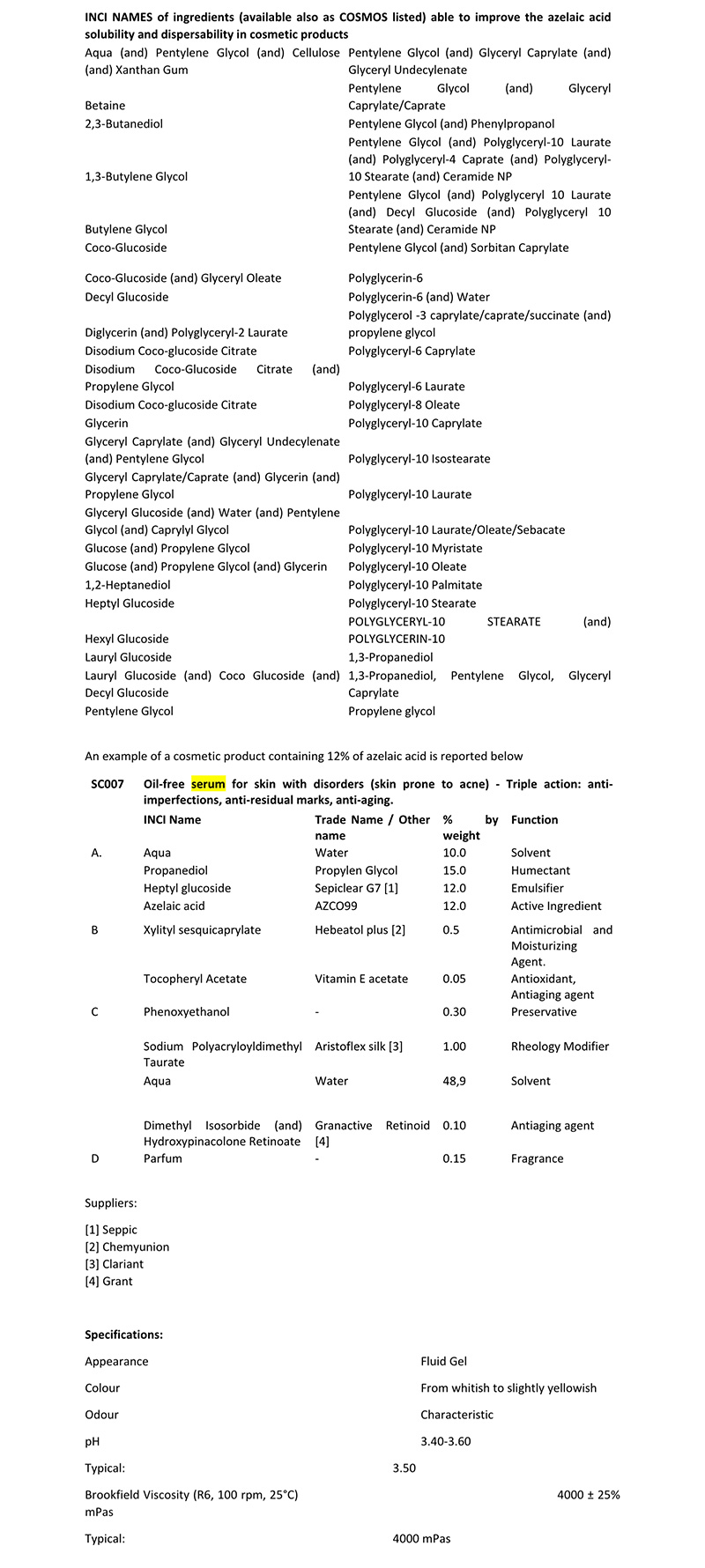It occurs amongst others in cereals like wheat, barley and rye. Extracts of these cereals have been used since 3000 years in Ayurveda products to treat hyperpigmentation (skin lightening). Azelaic acid also exhibits bactericidal properties, and it demonstrated to be very effective for the treatment of acne vulgaris. Azelaic acid extracted from natural resources is not economically feasible and then not commercially available; the extraction process is very difficult and expensive. On the other hand, azelaic acid can also be produced by ozonisation of oleic acid. Ozonisation is a hazardous reaction that can easily run out of control.
The alternative is oxidation of the oleic acid chain largely present in the triglicerides of the most common vegetable oils with hydrogen peroxide, which is much more environmentally friendly than ozone. This choice of starting material enables to produce a grade of azelaic acid of more than 99% purity where regular azelaic grades are specified at 85-90%.

Azepur99®
Vegetable-based azelaic acid is today commercially available as cosmetic grade, 99% minimum purity, under the trade name Azepur99®. Azepur99® is worldwide used for the obtainment of high value cosmetic products, where it can be applied at low percentage, often in combination with other actives such as niacinamide, salycilic acid, glycolic acid etc., but more and more, also at high percentage (10-15 %) as the only contained active. Azelaic acid was initially discovered by Drs. Marcella Nazzaro-Porro and Siro Passi of the S. Gallicano Dermatological Institute, Rome, and applied clinically with benefit to some cutaneous hyperpigmentary disorders. Subsequent collaborative laboratory and clinical studies in Rome, Turin, and London, and later at other centres, have established that azelaic acid is an inhibitor of tyrosinase, mitochondrial enzymes of the respiratory chain of DNA synthesis, and that it has an anti-proliferative and cytotoxic effect on a variety of tumoural cells in culture, normal cells being practically unaffected.
It is a scavenger of harmful free radicals, it inhibits generation of reactive oxygen species by neutrophils, and has broad spectrum bactericidal activity towards a range of microorganisms. Controlled clinical trials have established topical azelaic acid as an effective treatment for acne and chloasma, and it can also be of benefit to selected cases of melanomain situ. Its potential role as adjuvant therapy for primary invasive melanoma, and as palliative therapy for disseminated melanoma and possibly other tumours, remains to be investigated. Its anti-free radical and anti-bacterial activities may be capable of exploitation against a range of infectious and inflammatory conditions. In consideration of the good results obtained In the pharma application and of its really good safety profile, azelaic acid has then been started to be used in a large range of cosmetics products for both skin and hair care. Today many cosmetic products based on azelaic acid are available from the market, it is applied in various skin care products: lotions, emulsion, gels and organogels, to impart antiflammatory, antibacterial and whitening action. Many of the efficacy data available in the art are in any case referred to products based on a high percentage of azelaic acid (12 -20 %).

Studies
For example, azelaic acid has been demonstrated to be effective for the treatment of rosacea. It is available as a 20% cream or a 15% hydrogel. It reduces inflammatory lesions and erythema in rosacea patients and also inhibits neutrophilic ROS (Reactive Oxygen Species). Azelaic acid is also a natural skin bleaching agent and a naturally effective lightener for the skin. It can be used both for integral skin lightening to obtain a more radiant complexion, but also to fight “old-age spots”. Studies were made to see how powerful this ingredient was to lighten complexion. In South America, a 24-week-long study took place and found that 20% concentration of Azelaic Acid was comparable to 2% hydroquinone in treating the skin disorder, azelaic acid for melasma.
Another study was conducted in the Philippines and found that 20% of azelaic acid was more effective than hydroquinone 4%. A placebocontrolled clinical study conducted on 52 women with dark or pigmented skin (phototypes IV to VI) suffering from melasma demonstrated the superiority of a cream containing 20% azelaic acid. It seems that the preparations containing 20% azelaic acid and 4% hydroquinone are equivalent in vivo. Side effects are virtually absent with azelaic acid. Azelaic acid is believed to function on the basis of its antimicrobial activity and/or normalisation of keratinisation (the process by which epithelial cells mature as they move towards the skin surface and are then desquamated). The European Union considers azelaic acid as a cosmetic ingredient that can be applied without concentration restrictions. In the US, azelaic acid is FDA approved for the treatment of acne and rosacea. A variety of products containing 10-25% azelaic acid are commercially available, mainly in the pharma market. In conclusion, azelaic acid is generally welltolerated also when used at very high percentage (20-25%) and can be used for extended periods. In consideration of all the available evidences, azelaic acid is surely able to give beneficial effect on skin when incorporated in cosmetic products at low percentages (3% -10%), but formulations such as serum, emulsions, based on percentages higher than 10% (between12%-15%) can give more reliable results regarding the treated skin, as many studies are available with a high scientific value for the pharma application of this active substance.
Solubility of Azelaic acid Since azelaic acid is poorly soluble in water and also in common polar organic solvents such as ethanol, some formulation tips are necessary to obtain a stable cosmetic product based on a high dosage of this active substance. Glycols, polyglycols, glycerin and polyglyceryl derivative are the best solvents to be used to obtain translucent stable concentrate solutions of azelaic acid. Azepur99®, thanks to its natural origin, is COSMOS listed and several ingredients able to increase the solubility of azelaic acid can be found in the list of COSMOS approved ingredients. So today, it is possible to prepare sustainable and environmentally friendly cosmetic products with high percentage of azelaic acid.
The table contains a list of substances able to improve the solubility/dispersability of azelaic acid in cosmetic products.

Manufacturing instructions
- In a melter, heat to 60 °C and mix until homogeneous: a yellowish transparent fluid gel is obtained. Cool to T <30 °C.
- Once phase A has cooled, add and mix Hebeatol and Tocopheryl Acetate . Indicative time 10 min, until transparency.
- In turbo-emulsifier, sprinkle the Aristoflex Silk while stirring. Continue until a homogeneous gel is formed
- Flush, possibly only gentle mixing and possibly with a very low force turbine, to avoid incorporating air. A whitish-yellowish gel is obtained.
Conclusions
Azelaic acid can be better defined as a cosmeceutical ingredient, in fact, it shows both cosmetic and pharmaceutical properties. Azelaic acid exhibits superior performance for the treatment of acne vulgaris, rosacea and melasma and skin lightening by means of enzyme inhibitions. The toxicological properties of azelaic acid are superior compared with the current pharmaceutical active ingredients used for the treatment of acne vulgaris or rosacea. The side effects of azelaic acid are minimal and can be mastered rather straightforwardly, using commercially available Azepur99®, the highest purity product in the market. Many efficacy data are available and they are based on products containing high percentage of azelaic acid (15% – 25%). Azepur99®, a real sustainable ingredient, 100% bio-based and palm oil free, obtained by a sustainable process from a definite vegetable source (high oleic sunflower oil) is the perfect choice for high-performing, multi-action way to act and sustainable cosmetic solutions for skin care.

